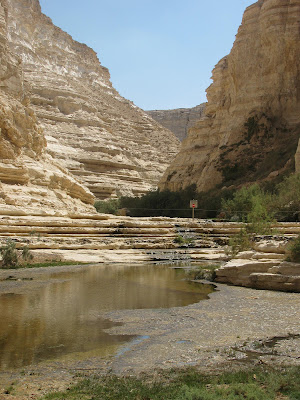I've visited many of Israel's national parks and thought that I knew my firm favourites. However, when we hiked at Ein Avdat in the Negev desert during our recent stay at Naot Farm, it quickly shot towards the top of my list!
Ein Avdat National Park is set within the incredible landscape of the Zin Valley in the centre of Israel’s Negev desert. Ein means spring or water source and Avdat derives from the nearby city of Avdat that stood south of the canyon. Avdat was named after the Nabataean King Obodas I. (Nabateans is an Arabic word meaning "cistern diggers".)
After the establishment of Kibbutz Sde Boker in 1952 and the construction of Highway 40 to Eilat, a hiking trail was created at Ein Avdat which is part of the Israel National Trail. The well marked trail takes you through some incredible desert scenery. It simply took my breath away.
The spectacular canyon is the result of power of the waters at Ein Avdat. The spring, an oasis amid the barren and rocky Negev desert, has carved a deep, narrow canyon through the rock. The source of the spring is not definitively known, but is generally thought to be rain water which seeps into the ground. A waterfall has formed, and the pools below it provide a source of life to animal life including ibex (a species of wild goat found in Asia and northern Africa), birds of prey and the various plants and trees which are able to flourish despite the challenging conditions.
There are two entrances into the Ein Avdat National Park: one at Midreshat Ben Gurion, and one 5km further south. It is possible to walk between the two, though this is really reserved for advanced hikers because it requires climbing metal rungs, and was also not suitable on a hot August day. We visited Ein Avdat from the lower Midreshat Ben Gurion entrance, walked along the streambed, and then returned to where we had begun before the last short segment of the trail.
The hike itself was an easy one. We followed the well marked route passing an Atlantic Terenbinth (Pistacia atlantica) tree that is about 250 years old. This tree is the sole remnant of what was probably a forest here. Other plants along the trail are more typical of the dry Negev desert including Euphrates poplar trees, atriplexes (commonly known as saltbush), and other salt-loving trees (the spring water at Ein Avdat is slightly salty). Also common to the area are Bulbul, rock pigeons, eagles, vultures, hawks, bustards, frogs, crabs, and of course the ibex.
Crossing the streambed we first arrived at the lower pools of Ein Avdat which are separated into two parts by a man-made dam, then climbed some narrow steps hewn into the rock which go around the 15 metre waterfall (these steps were initially carved by Israeli youth in the 1950s). From the top we were able to gaze down into the spectacular canyon and the pools below.
We continued to follow the trail along the stream to a grove of Mesopotamian poplars. This is where we had a break and spent some time watching the beautiful ibex, native residents of this canyon, and the vultures nesting on the cliffs. On the wall of the cliff you can see the mouths of caves where monks dwelt during the Byzantine period until the Muslim conquest of the area. The monks sculpted shelves, benches, stairs, and water systems from the rock. The caves were also decorated with crosses and prayers were engraved in the rock of the caves. It is possible that the area of the poplar grove was once a vegetable garden cultivated by the monks who lived in the nearby caves.
From here, additional steps and two ladders lead first to the Ein Ma'arif spring, the initial source of the Ein Avdat waterfall, and on to the upper observatory at the southern end of the park. We needed to turn around at this point and make our way back to our car in the lower car park. The hike had taken us well over the one hour that had been suggested, though we were fascinated by the ibex and did stop to watch them and take photos at every opportunity!
In Israel, ibex are common in the Negev, the hills around Eilat, and the Judean mountains in the vicinity of the Dead Sea. The ibex roam around the cliffs and steep slopes which are its natural habitat. Its range is always in the vicinity of streams, springs or waterholes rich in vegetable life.
Besides man, their only natural enemy is the leopard, which once flourished in the Negev and is still found at Ein Gedi. The ibex population in Israel, once depleted, has been recovering over the past several years thanks to stricter enforcement of the nature reserve laws and strict prohibition on hunting.
Back in our car we drove to the observatory at the upper end of Ein Avdat to enjoy the magnificent panorama of the canyon, fortunately arriving just before it closed at 4pm. It was awesome! Once again we watched two or three ibex navigate the steep, rocky slopes with ease. Its brown colour, solid body and muscular legs, as well as the special structure of its hoofs which gives it excellent rock-climbing ability, together enable it to exist and survive under harsh desert and mountain conditions. Sadly we are not built in quite the same way and it was time for the air conditioning and some rest. There was more to come the following day.
* This post has been shared on Welcome To The Weekend Link Up, All Seasons, The Good. The Random. The Fun., Wordless Wednesday (on Tuesday), The Keeping It Real Link Up, Tuesday's Treasures and Thankful Thursday.























































